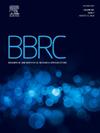Junctophilin-2 is a double-stranded RNA-binding protein that regulates cardiomyocyte-autonomous innate immune response
IF 2.5
3区 生物学
Q3 BIOCHEMISTRY & MOLECULAR BIOLOGY
Biochemical and biophysical research communications
Pub Date : 2024-09-20
DOI:10.1016/j.bbrc.2024.150725
引用次数: 0
Abstract
Junctophilin-2 (JPH2) is traditionally recognized as a cardiomyocyte-enriched structural protein that anchors the junction between the plasma membrane and the endo/sarcoplasmic reticulum, facilitating excitation-induced cardiac contraction. In this study, we uncover a novel function of JPH2 as a double-stranded RNA (dsRNA)-binding protein, which forms complexes with dsRNA both in vitro and in cells. Stimulation by cytosolic dsRNA enhances the interaction of JPH2 with the dsRNA sensor MDA5. Notably, JPH2 inhibits MDA5's binding to its dsRNA ligand, likely by sequestering the dsRNA. Silencing JPH2 in cardiomyocytes increased the interaction between MDA5 and its dsRNA ligands, activated the MAVS/TBK1 signaling, and triggered spontaneous interferon-beta (IFNb1) production in the absence of foreign pathogen. Mouse hearts deficient in JPH2 exhibited upregulation of innate immune signaling cascade. Collectively, these findings identify JPH2 as a regulator of dsRNA sensing and highlight its role in suppressing the automatic activation of innate immune responses in cardiomyocytes, suggesting the cytosolic surface of the endo/sarcoplasmic reticulum as a hub for dsRNA sequestration.

Junctophilin-2 是一种双链 RNA 结合蛋白,能调节心肌细胞自主的先天性免疫反应
交界嗜蛋白-2(JPH2)传统上被认为是一种富含心肌细胞的结构蛋白,它能锚定质膜和内/质网之间的交界处,促进兴奋诱导的心脏收缩。在这项研究中,我们发现了 JPH2 作为双链 RNA(dsRNA)结合蛋白的新功能,它在体外和细胞内都能与 dsRNA 形成复合物。细胞质dsRNA的刺激增强了JPH2与dsRNA传感器MDA5的相互作用。值得注意的是,JPH2 可抑制 MDA5 与其 dsRNA 配体的结合,这可能是通过封存 dsRNA 实现的。在心肌细胞中沉默 JPH2 会增加 MDA5 与其 dsRNA 配体之间的相互作用,激活 MAVS/TBK1 信号传导,并在没有外来病原体的情况下触发自发干扰素-β(IFNb1)的产生。缺乏 JPH2 的小鼠心脏表现出先天性免疫信号级联的上调。总之,这些发现确定了 JPH2 是 dsRNA 感知的调控因子,并强调了它在抑制心肌细胞先天性免疫反应自动激活中的作用,表明内/质网的胞浆表面是 dsRNA 封存的枢纽。
本文章由计算机程序翻译,如有差异,请以英文原文为准。
求助全文
约1分钟内获得全文
求助全文
来源期刊
CiteScore
6.10
自引率
0.00%
发文量
1400
审稿时长
14 days
期刊介绍:
Biochemical and Biophysical Research Communications is the premier international journal devoted to the very rapid dissemination of timely and significant experimental results in diverse fields of biological research. The development of the "Breakthroughs and Views" section brings the minireview format to the journal, and issues often contain collections of special interest manuscripts. BBRC is published weekly (52 issues/year).Research Areas now include: Biochemistry; biophysics; cell biology; developmental biology; immunology
; molecular biology; neurobiology; plant biology and proteomics

 求助内容:
求助内容: 应助结果提醒方式:
应助结果提醒方式:


